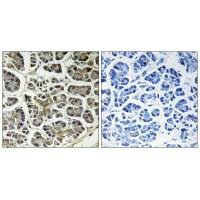
Immunohistochemistry analysis of paraffin-embedded human pancreas tissue using ATP5G2 antibody.
ATP5G2 Antibody

CSB-PA697579
ApplicationsELISA, ImmunoHistoChemistry
Product group Antibodies
ReactivityHuman
TargetATP5MC2
Overview
- SupplierCusabio
- Product NameATP5G2 Antibody
- Delivery Days Customer20
- ApplicationsELISA, ImmunoHistoChemistry
- CertificationResearch Use Only
- ClonalityPolyclonal
- ConjugateUnconjugated
- FormulationLiquid
- Gene ID517
- Target nameATP5MC2
- Target descriptionATP synthase membrane subunit c locus 2
- Target synonymsATP synthase c subunit; ATP synthase F(0) complex subunit C2, mitochondrial; ATP synthase lipid-binding protein, mitochondrial; ATP synthase proteolipid P2; ATP synthase proton-transporting mitochondrial F(0) complex subunit C2; ATP synthase, H+ transporting, mitochondrial F0 complex, subunit C2 (subunit 9); ATP synthase, H+ transporting, mitochondrial Fo complex subunit C2 (subunit 9); ATP5A; ATP5G2; ATPase protein 9; ATPase subunit C; dicyclohexylcarbodiimide (DCCD)-reactive proteolipid subunit
- HostRabbit
- IsotypeIgG
- Protein IDQ06055
- Protein NameATP synthase F(0) complex subunit C2, mitochondrial
- Scientific DescriptionMitochondrial membrane ATP synthase (F1F0 ATP synthase or Complex V) produces ATP from ADP in the presence of a proton gradient across the membrane which is generated by electron transport complexes of the respiratory chain. F-type ATPases consist of two structural domains, F1 - containing the extramembraneous catalytic core and F0 - containing the membrane proton channel, linked together by a central stalk and a peripheral stalk. During catalysis, ATP synthesis in the catalytic domain of F1 is coupled via a rotary mechanism of the central stalk subunits to proton translocation. Part of the complex F0 domain. A homomeric c-ring of probably 10 subunits is part of the complex rotary element. HAMAP-Rule MF_01396 Dyer M.R., Biochem. J. 293:51-64(1993). Higuti T., Biochim. Biophys. Acta 1173:87-90(1993). Farrell L.B., Biochem. Biophys. Res. Commun. 144:1257-1264(1987).
- ReactivityHuman
- Storage Instruction-20°C or -80°C
- UNSPSC12352203
